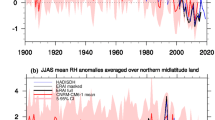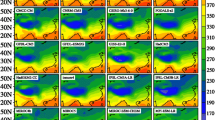Abstract
Based on numerical experiments using the NCAR CAM3-CLM3 models, this paper examines the impact of soil moisture, vegetation, and sea surface temperature (SST) on the inter-annual variability of climate over land. For each element, two experiments are carried out, with the inter-annual variability preserved in one experiment and eliminated in the other. Differences in the standard deviation of the precipitation and air temperature at the inter-annual time scale are used to quantify the impacts from soil moisture dynamics, vegetation dynamics, and oceanic forcing. The impact of oceanic forcing is mainly limited to the Tropics, with the strongest signal in the equatorial zone, and moisture convergence is the key linkage between SST forcing and tropical precipitation. Soil moisture plays a significant role in climate variability during the rainy seasons of all semi-arid regions (which is consistent with many previous studies), and during the dry seasons of the humid Amazon. Evapotranspiration is identified as the main mechanism linking precipitation variability to soil moisture. Amazon is the only region where vegetation dynamics has a significant influence on precipitation variability. However, the impact of vegetation dynamics on temperature is strong over the US Great Plains in all four seasons and in the Amazon region during the dry and dry-to-wet transition seasons.









Similar content being viewed by others

References
Alessandri A, Navarra A (2008) On the coupling between vegetation and rainfall inter-annual anomalies: possible contributions to seasonal rainfall predictability over land areas. Geophys Res Lett 35:L02718. doi:10.1029/2007GL032415
Anyamba A, Tucker C (2005) Analysis of Sahelian vegetation dynamics using NOAA-AVHRR NDVI data from 1981–2003. J Arid Environ 63:596–614
Barbosa HA, Huete A, Baethgen W (2006) A 20-year study of NDVI variability over the Northeast Region of Brazil. J Arid Environ 67:288–307
Cherchi A, Gualdi S, Behera S et al (2007) The influence of Tropical Indian Ocean SST on the Indian summer monsoon. J Clim 20:3083–3105
Collins WD et al (2004) Description of the NCAR community atmosphere model 579 (CAM3.0). Tech Rep, NCAR/TN-464 + STR, Natl Cent for Atmos Res, Boulder, Colo
Cox PM, Betts RA, Jones CD, Spall SA, Totterdell IJ (2000) Acceleration of global warming due to carbon-cycle feedbacks in a coupled climate model. Nature 408:184–187
Dirmeyer PA (2001) An evaluation of the strength of land-atmosphere coupling. J Hydrometeorol 2:329–344
Dirmeyer PA (2006) The hydrologic feedback pathway for land-climate coupling. J Hydrometeorol 7:857–867
Dirmeyer PA (2011), The terrestrial segment of soil moisture-climate coupling. Geophys Res Lett 38. doi:10.1029/2011GL048268
Dirmeyer PA, Schlosser CA, Brubaker KL (2009) Precipitation, recycling, and land memory: an integrated analysis. J Hydrometeorol 10:278–288
Easterling DR, Meehl GA, Parmesan C, Changnon SA, Karl TA, Mearns LO (2000) Climate extremes: observations, modeling and impacts. Science 289:2068–2074
Fu R, Dickinson RE, Chen M, Wang H (2001) How do tropical sea surface temperatures influence the seasonal distribution of precipitation in the equatorial Amazon? J Clim 14:4003–4026
Giannini A, Saravanan R, Chang P (2003) Oceanic forcing of Sahel rainfall on interannual to interdecadal time scales. Science 302:1027–1030
Goddard L, Graham NE (1999) Importance of the Indian Ocean for simulating rainfall anomalies over eastern and southern Africa. J Geophys Res 104:19099–19116
Guo Z-C et al (2006) GLACE: the global land–atmosphere coupling experiment. Part II: analysis. J Hydrometeorol 7:611–625
Hurrell JW, Hack JJ, Shea D, Caron JM, Rosinski J (2008) A New Sea Surface Temperature and Sea Ice Boundary Dataset for the Community Atmosphere Model. J Clim 21:5145–5153
Juneng L, Tangang FT (2005) Evolution of ENSO-related rainfall anomalies in Southeast Asia region and its relationship with atmosphere–ocean variations in Indo-Pacific sector. Clim Dyn 25:337–350
Katz RW, Brown BG (1992) Extremee vents in a changing climate: variability is more important than averages. Clim Change 21:289–302
Kim YJ, Wang GL (2007a) Impact of initial soil moisture anomalies on subsequent precipitation over North America in the coupled land–atmosphere model CAM3-CLM3. J Hydrometeorol 8:534–550
Kim YJ, Wang GL (2007b) Impact of vegetation feedback on the response of precipitation to antecedent soil moisture anomalies over North America. J Hydrometeorol 8:534–550
Koster RD, Suarez MJ, Heiser M (2000) Variance and predictability of precipitation at seasonal to interannual timescales. J Hydrometeorol 1:26–46
Koster RD, Dirmeyer PA, Hahmann AN, Ijpelaar R, Tyahla L, Cox P, Suarez MJ (2002) Comparing the degree of land–atmosphere interaction in four atmospheric general circulation models. J Hydrometeorol 3:363–375
Koster RD et al (2006) GLACE: the global land–atmosphere coupling experiment. Part I: overview. J Hydrometeorol 7:590–610
Liu Z, Notaro M, Kutzbach J, Liu N (2006) Assessing global vegetation–climate feedbacks from observations, J. Climate 19:787–814
Meehl GA et al (2000) Trends in extreme weather and climate events: issues related to modeling extremes in projections of future climate change. Bull Am Meteorol Soc 81:427–436
Mei R, Wang G (2011) Impact of sea surface temperature and soil moisture on summer precipitation in the United States based on observational data. J Hydrometeorol 12:1086–1099. doi:10.1175/2011JHM1312.1
Mei R, Wang G (2012) Summer land-atmosphere coupling strength in the United States: comparison among observations, reanalysis data and numerical models. J Hydrometeorol in press
Nemani RR et al (2003) Climate-driven increases in global terrestrial net primary production from 1982 to 1999. Science 300:1560–1563
Notar M, Chen G, Liu Z (2011) Vegetation feedbacks to climate in the global monsoon regions. J Clim 24:5740–5756, doi: 10.1175/2011JCLI4237.1
Notaro M (2008a) Response of the mean global vegetation distribution to interannual climate variability. Clim Dynam 30:845–854
Notaro M (2008b) Statistical identification of global hot spots in soil moisture feedbacks among IPCC AR4 models. J Geophys Res 113:D09101. doi:10.1029/2007JD009199
Notaro M, Liu Z (2008) Statistical and dynamical assessment of vegetation feedbacks on climate over the boreal forest. Clim Dyn 31:691–712. doi:10.1007/s00382-00008-00368-00388
Notaro M, Liu Z, Williams JW (2006) Observed vegetation-climate feedbacks in the United States. J Clim 19:763–786. doi:10.1175/JCLI3657.1
Notaro M, Wang Y, Liu Z, Gallimore R, Levis S (2008) Combined statistical and dynamical assessment of simulated vegetation–rainfall interactions in North Africa during the mid-Holocene. Glob Chang Biol. doi:10.1111/j.1365-2486.2007.01495.x
Orlowsky B, Seneviratne SI (2010) Statistical analyses of land-atmosphere feedbacks and their possible pitfalls. J Clim 23:3918–3932. doi:10.1175/2010JCLI3366.1
Rasmusson EM, Carpenter TH (1982) Variations in tropical sea surface temperature and surface wind fields associated with the Southern Oscillation/El Niño. Mon Wea Rev 110:354–384
Salinger MJ (2005) Climate variability and change: past, present, and future—an overview. Clim Change 70:9–27
Santanello JA, Peters-Lidard CD, Kumar SV (2011) Diagnosing the sensitivity of local land-atmosphere coupling via the soil moisture-boundary layer interaction. J Hydrometeorol 12:766. doi:10.1175/JHM-D-10-05014.1
Schubert D et al (2004) Causes of long-term drought in the US Great Plains. J Clim 17(3):485–503
Seneviratne SI, Lüthi D, Litschi M, Schär C (2006) Land–atmosphere coupling and climate change in Europe. Nature 443:205–209
Seneviratne SI, Corti T, Davin EI et al (2010) Investigating soil moisture-climate interactions in a changing climate: a review. Earth Sci Rev 99:125–161
Sun S, Wang GL (2011) Diagnosing the equilibrium state of a coupled global biosphere-atmosphere model. J Geophys Res. doi:10.1029/2010JD015224
Sun S, Wang GL (2012) The complexity of using a feedback parameter to quantify the soil moisture-precipitation relationship. J Geophys Res. doi:10.1029/2011JD017173
Trenberth KE, Branstator Karoly D, Kumar A, Lau N-C, Ropelewski C (1998) Progress during TOGA in understanding and modeling global teleconnections associated with tropical sea surface temperatures. J Geophys Res 103:14291–14324
Wang GL, Kim YJ, Wang D (2007) Quantifying the strength of soil moisture-precipitation coupling and its sensitivity to changes in surface water budget. J Hydrometeorol 8:551–570. doi:10.1175/JHM573.1
Wang GL, Sun S, Mei R (2011) Vegetation dynamics contributes to the multi-decadal variability of precipitation in the Amazon region. Geophys Res Lett 38:L19703. doi:10.1029/2011GL049017
Wang F, Notaro M, Liu Z (2012), Influence of vegetation on the climate across North America—observational and modeling study. J Clim, in preparation
Wei J, Dickinson RE, Chen H (2008) A negative Soil moisture–precipitation relationship and its causes. J Hydrometeorol 9:1364–1376
Zeng XB, Barlage M, Castro C, Fling K (2010) Comparison of land–precipitation coupling strength using observations and models. J Hydrometeorol 11:979–994. doi:10.1175/2010JHM1226.1
Zhang J, Wang WC, Wei J (2008) Assessing land-atmosphere coupling using soil moisture from the Global Land Data Assimilation System and observational precipitation. J Geophys Res 113:D17119. doi:10.1029/2008JD009807
Acknowledgments
This work was supported from funding from NSF (ATM 0531845) and NOAA (NA080AR4310871). The authors thank the three anonymous reviewers for their constructive comments.
Author information
Authors and Affiliations
Corresponding author
Rights and permissions
About this article
Cite this article
Sun, S., Wang, G. Climate variability attributable to terrestrial and oceanic forcing in the NCAR CAM3-CLM3 Models. Clim Dyn 42, 2067–2078 (2014). https://doi.org/10.1007/s00382-013-1913-7
Received:
Accepted:
Published:
Issue Date:
DOI: https://doi.org/10.1007/s00382-013-1913-7



